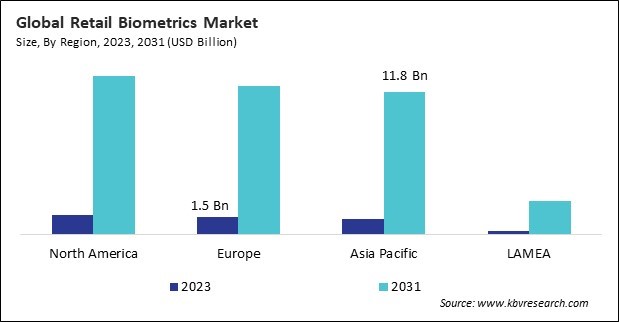Int'l : +1(646) 600-5072 | query@kbvresearch.com
Int'l : +1(646) 600-5072 | query@kbvresearch.com
Industry Insights | Market Trends | Highest number of Tables | 24/7 Analyst Support
According to a new report, published by KBV research, The Global Retail Biometrics Market size is expected to reach $40 billion by 2031, rising at a market growth of 31.7% CAGR during the forecast period.
The Facial Recognition segment is anticipating a CAGR of 31.1% during (2024 - 2031). The increasing demand for contactless identification solutions, especially in the post-pandemic era, has significantly boosted the adoption of facial recognition technology in retail. This technology allows for seamless and quick identification of customers, enhancing the overall shopping experience. Retailers leverage facial recognition for personalized customer service, targeted marketing, and efficient security measures. The advancement in AI and machine learning algorithms has improved the accuracy and reliability of facial recognition systems, making them a valuable tool for modern retailers.

The On-Premises segment is leading the Global Retail Biometrics Market by Deployment Mode in 2023; thereby, achieving a market value of $21.5 billion by 2031. This segment's dominance is attributed to the enhanced control and security that on-premises deployment offers to retailers. By keeping biometric data and systems within their infrastructure, retailers can ensure compliance with stringent data protection regulations and maintain tighter control over their security measures. Additionally, on-premises deployment allows customization to meet specific organizational needs and integrates seamlessly with existing in-house systems. The preference for on-premises solutions is particularly strong among large retailers with substantial IT resources and infrastructure.
The Customer Identification & Loyalty Programs segment is registering a CAGR of 30.4% during (2024 - 2031). Retailers increasingly leverage biometric technology to enhance customer identification processes and improve loyalty program experiences. Biometrics enables seamless and accurate identification of customers, allowing for personalized services and targeted marketing efforts. By integrating biometrics into loyalty programs, retailers can offer customers a more secure and convenient way to access rewards and benefits. Recognizing and understanding customer preferences through biometric data also helps retailers build stronger relationships with their customers, ultimately driving customer retention and loyalty.
The Hardware segment is generating the maximum revenue in the Global Retail Biometrics Market by Component in 2023, thereby, achieving a market value of $15.8 billion by 2031. This segment's leading position is driven by the essential role of biometric hardware devices, such as fingerprint scanners, facial recognition cameras, iris scanners, and voice recognition systems, in implementing biometric solutions. The demand for robust and reliable hardware components has increased as retailers seek to enhance security, improve customer experience, and streamline operations.
The Specialty Stores segment shows a CAGR of 30.6% during (2024 - 2031). Specialty stores, which focus on specific product categories, are increasingly utilizing biometric technologies to differentiate themselves in a competitive retail environment. Biometrics are used in specialty stores for secure access control, personalized customer interactions, and efficient workforce management. Adopting biometric solutions helps these stores offer a unique and secure shopping experience, attracting and retaining customers. The ability to provide tailored services and enhance operational efficiency has contributed to the growing revenue share of the specialty stores segment in the retail biometrics market.
Full Report: https://www.kbvresearch.com/retail-biometrics-market/
The North America region dominated the Global Retail Biometrics Market by Region in 2023, and would continue to be a dominant market till 2031; thereby, achieving a market value of $9.8 billion by 2031. The Europe region is anticipated to grow at a CAGR of 10.1% during (2024 - 2031). Additionally, The Asia Pacific region would witness a CAGR of 11% during (2024 - 2031).
By Deployment Mode
By Type
By Component
By Application
By Retail Type
By Geography
Related Reports: